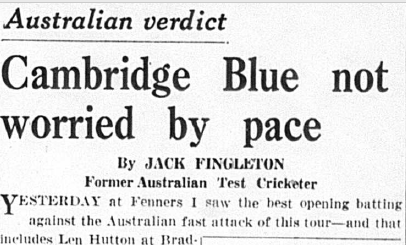Mike Bushby loved to talk about cricket but was evasive about his own achievements
There cannot be many of us left who had the privilege of opening the batting with Mike Bushby. The Covid-enforced abandonment of a memorial service for his life ensures that we remain one of those eccentric clubs whose members never meet.
My own good fortune was limited to two or three occasions at Tonbridge in the late 1970s, now blurred into a single recollection. It may have been Yellowhammers cricket week. Richard Gracey had won the toss but brought news that our opponents had a “ringer”, a young South African fast bowler with a reputation for hospitalising opening batsmen. My older team-mates knew how to avoid catching the captain’s eye as he wrote down the batting order. I was duly summoned to open with Bushby.
By this period Mike’s presence at the crease could not be described as commanding. His request for a guard was apologetic. His bat lacked the substance that had become fashionable. There was something reluctant in his demeanour.
Emboldened by these preliminaries, the South African called over his captain, requesting that square leg should move up to short leg. The unfortunate fielder was a regular in these games and knew what Bushby could do. Never have I seen a cricketer who so visibly wished he had stayed at home.
Sure enough, after a couple of looseners, the bowler unleashed a ferocious bouncer. It was as though a slumbering hound had been tossed a favourite bone. Instantly Mike was at his full height, pivoting slightly to face the ball, the bat poised. Unlike most masters of the hook shot, satisfied with helping the ball on its way, Bushby’s stroke was a slashing blow, of unnecessary violence.
I recall the ball bouncing back off the chapel wall on to the ground. Mike shared a humorous aside, something about the whites of the eyes of that short leg fielder.
******
The trouble with the hook shot was that we could discover little more about Mike Bushby the cricketer, in his Cambridge heyday.
A fervent modesty, accentuated by resolve to forge his career in the classroom rather than the playing fields, ensured that Mike became an antidote to the name-dropping raconteur of varsity heroics. By the time I first knew him in the late 1960s, Bushby had perfected the art of describing cricket at Cambridge as an historian, rather than a participant.
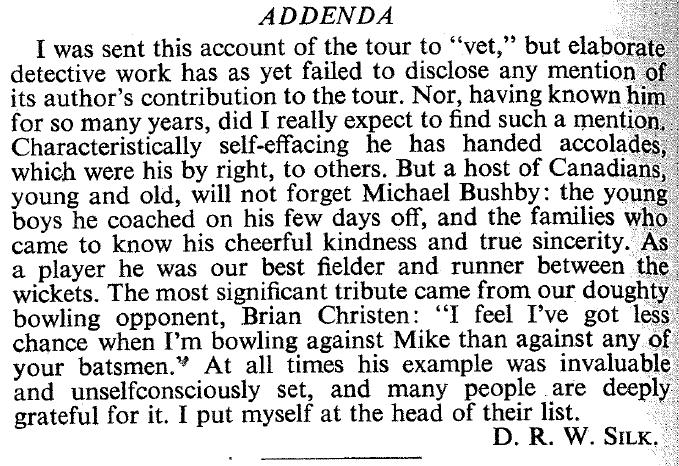
The Bushby modesty was well honed by 1959 when The Cricketer published his 3-page blow-by-blow account of the MCC tour to Canada. The omission of any reference to his own 25 innings compelled the tour captain, Dennis Silk, to submit this footnote.
Mike had toured Argentina for MCC in the previous winter. He described the pitches there as the best he had known.
We were justified in our curiosity. Bushby faced all the great English bowlers of the 1950s – Bedser and Bailey, Trueman and Statham, Laker and Lock; not to mention his encounter with the Australian, Ray Lindwall. At cover point he was kept busy by the master batsmen of that era as they piled up runs against the University – Hutton and Washbrook, Compton and Edrich, May, Cowdrey and Graveney. Mike even contrived to enjoy a lengthy partnership with Sir Len Hutton in the great man’s final first class match.
Occasionally he gave the game away. Mike was a good mimic, especially of north country accents. He enjoyed recounting how Fred Trueman would barge into his opponents’ changing room just before Yorkshire took the field, primed with bloodthirsty threats levelled at the opening batsmen. When you heard this tale in reported speech, culminating in: “I’ll knock your fookin’ ‘ed off,” you knew that Mike had been on the receiving end.
******
Mike Bushby was captain of Cambridge University in 1954, earning the respect of cricketers everywhere for the rest of his life, such was the reputation of Cambridge cricket at that time.
A customary stepping stone to captaincy of the University was a place in the eleven in your first year. Mike’s timing was unfortunate, to say the least. The scramble for selection in 1952 was quite unprecedented.
Of the eleven that eventually played in the Varsity match, four had already experienced test cricket; two more would do so, and a seventh would take almost 1,000 wickets in first class cricket. Of the batsmen, no fewer than four would score centuries against Australia in later years; two others had already played for their counties. Bushby had been deprived of serious cricket for two summers, detained by National Service. Not a hope!
The 1952 University captain, David Sheppard, explained the selection process in his autobiography: “every April 120 hopeful cricketers would be invited to come up early for the Summer term.” Practice nets every day for a week, followed by trial matches.
Bushby somehow emerged from this beauty parade to gain selection for the opening match. “They just happened to need an opening batsman”, he told me, as though none of those 120 young hopefuls had similar claims, not least Dennis Silk who became Mike’s Cambridge opening partner in subsequent years.
Although Mike had played representative cricket for Public Schools, nothing could have prepared him for the experience of those early matches at Fenner’s. He opened with Sheppard, with Peter May at number three, both future England captains who together headed the first class averages from start to finish of that summer. In the seven drawn matches against counties and the Indian tourists that opened the season at Fenner’s, Cambridge never looked in danger of losing and often came close to winning.
People turned up to watch; 6,000 for the first day against Lancashire was not untypical. A strong Yorkshire side was kept afloat by two half centuries from Len Hutton. In The Telegraph Jim Swanton offered a typically concise summary: “it was a considerable feather in the Light Blue cap to out-bat, out-bowl and out-field Yorkshire for 3 days, in conditions equal for both.”
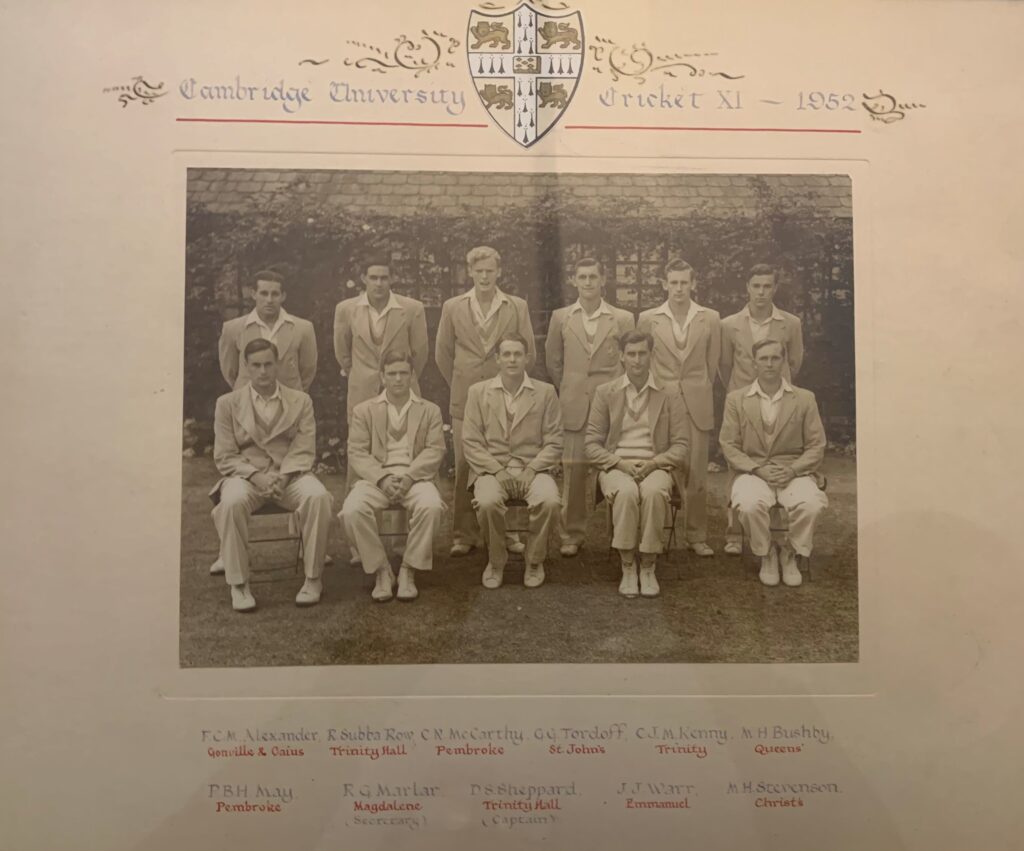
Mike was confronted with a steep learning curve over those memorable weeks. He told me that that he barely knew his team-mates. He had to score enough runs to be awarded his blue by early June, when the fixtures moved away from Fenner’s, culminating in the Varsity match at Lord’s.
He came under pressure immediately. Bowled for a duck in the first over of the opening match. Run out in the only innings of the second match. Then two further run outs in that short period, through misunderstandings with Sheppard.
Despite these disasters, the student newspaper, Varsity, was quick to note that “(Bushby) has a sound temperament and good technique” and, only a week later, that “Bushby improves visibly with every innings.” Swanton complimented Bushby’s “meticulously perpendicular straight bat.”
Mike survived several of those awkward short evening sessions that can make or break an opening batsman – and impress your captain. On June 7th, a formal notice duly appeared in The Times: “the Cambridge University captain has invited M.H.Bushby…..to play against Oxford at Lord’s on July 5.”
On the eve of the much later encounter in 1998, The Guardian sports pages included an entertaining cricket feature, “Everything you wanted to know about the Varsity match”, offering snippets of history from 1827. Under the sub-heading “Best XI” across those 170 years, there was no discussion, just the simple answer.
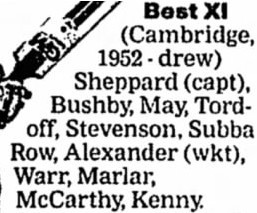
Winning selection and holding his place in this formidable team was Mike’s pivotal achievement in cricket.
Questions remained as the 1953 season approached. Bushby had the technique to see off an opening attack but had stumbled over the next phase of an innings – scoring runs against the defensive field-placing and pinpoint accuracy of professional bowlers.
Having spent 1952 sandwiched between May and Sheppard in the batting order, Mike can hardly be blamed for imitating their methods. On the notoriously flat pitches at Fenner’s both men had developed the confidence to attack bowlers through hard hitting, without waiting for bad balls. Peter May in particular became the best onside player of his time, smashing length bowlers wide of mid-on at will.
Mike was immediately successful. He made his first century for Cambridge on the opening day of the 1953 season against Sussex. But from this point Bushby was known to favour the legside for run-scoring, the “perpendicular straight bat” described by Swanton in 1952 evolving into the “pulled drive”. Its rewards were high, but so were the risks.
******
From the moment the Australian tourists arrived in April 1953, the English cricketing public suffered collective anxiety about the threat posed by Ray Lindwall, then at the zenith of his reputation. The editor of The Cricketer frayed these nerves to the limit with a full page feature under the heading: “Is he the greatest fast bowler ever seen?”
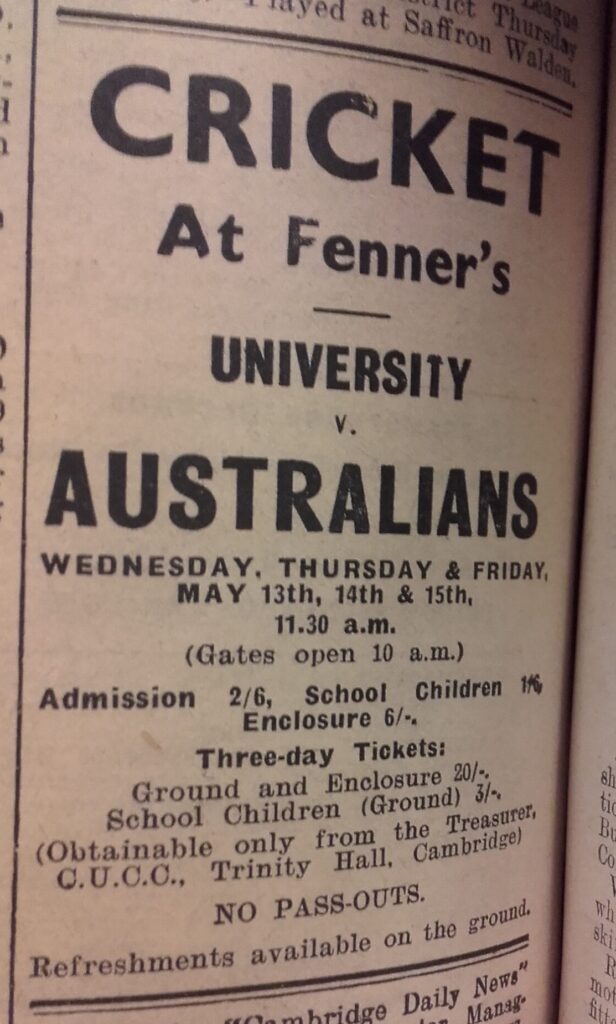
Events on the field offered no respite. In consecutive matches in early May, Surrey and Yorkshire were both crushed by the Australians by an innings in less than two days. If the two strongest counties of that period were unable to cope with the attack led by Lindwall, what might be in store for Cambridge University in the next fixture?
Ashes pessimism and fears of a turkey shoot did not deter more than 10,000 cricket fans from paying their half-crowns for admission on the first day; “the largest crowd ever seen at Fenner’s,” declared The Cricketer. The Telegraph agreed: “a crowd larger than the Fenner’s ground could comfortably contain spilled further and further over the running track on to the field.”
With the Australians batting first, the crowd had to wait until nearly six o-clock to see Lindwall bowl. “There followed 40 minutes of electric excitement”, reported Varsity, “Lindwall bowled like the wind.”
The Daily Mail noted that Lindwall set his normal field for the tour: “four slips, a gully and two short legs but, unlike the Surrey batsmen, Bushby and Silk were not intimidated.” Within ten minutes Mike had hit three boundaries, two of them off Lindwall. “Bushby showed some of the best strokes of the day,” wrote Jim Swanton.
A week earlier Surrey has been all out for 58 against the same attack. Here, Cambridge passed 30 without loss in no time. It was this unexpected rebuff to the Australian juggernaut, burnished with Mike’s confident handling of Lindwall, that generated the “electric excitement.” The thrill of watching a great fast bowler meet spirited resistance stayed in the memories of those who were there.
Mike hit six fours before his dismissal by Lindwall for 34, in the last over – an awful lbw decision for which the Australians apologised afterwards. Earlier in the day, Mike had reeled off one of his virtuoso fielding displays. The visitors rattled up a total of 383, aided partly, according to The Times, by “the ragged standard of the fielding, a general failing that was sharply underlined by the excellence of Bushby in the covers.”
All in all a good day’s work. Mike’s short innings was praised in all the English papers as a contribution to an entertaining day’s cricket. “As the shadows lengthened this evening Bushby played as delightfully as anyone during the day,” wrote John Woodcock in the Manchester Guardian.

******
That might have been the end of the matter, had not the two senior Australian reporters on the tour, veterans of 45 test matches, seen something that their English counterparts, with barely a first class match between them, did not see. Never mind the entertainment; here is a future England opening batsman was the unequivocal view of both Jack Fingleton and Bill O’Reilly, legends of the 1930s.
Fingleton was then Australia’s most respected writer on cricket. His book Cricket Crisis, published in 1946, remains a classic. Devoting almost his entire report to that evening session, he bet the farm on Bushby:
Yesterday at Fenners I saw the best opening batting against the Australian fast attack of this tour – and that includes Len Hutton at Bradford last week…….if I were an English selector I would not hesitate on yesterday’s showing, in having Bushby now in every game that counts against the Australians.
O’Reilly was a more punchy writer, ready to bash the Poms, especially for feeble resistance to short-pitched fast bowling. That day at Cambridge turned him into a pussycat:
English cricket has supplied a pleasant personality in the Cambridge team. In young opening batsman, Michael Bushby, the university has a boy of whom the Australians are likely to hear a great deal. If he is able to devote the necessary time to the game, they are likely to see him in person later on.
….I saw sufficient to recognise in him an outstanding batsman of the future. His upright stance, his poise and his ability to step lightly into the correct position to play a shot showed him to be by far the most outstanding contribution that English cricket has made to its future in games against the Australians to date.
O’Reilly wrote for the Melbourne Herald; Fingleton for the British regional paper, the Western Mail and South Wales News. I wonder if these match reports ever reached Cambridge, let alone the desks of the England selectors.
Such far-reaching judgement based on 40 minutes of cricket may seem hasty but is the stock-in-trade of journalists and selectors, then as now. Both Fingleton and O’Reilly offered technical analysis in support of their views. They liked Mike’s stance with the bat positioned between the feet, the low backlift, his quickness to get into position and, of course, they admired an opener who went for the hook shot.
The two Australians were battered veterans of the Bodyline series and knew a good player of fast bowling when they saw one. Their case was strengthened in the weeks that followed. From Cambridge the Australians moved on to Lord’s to play MCC, effectively an England test trial. In the first half hour of the match, Lindwall disposed of Simpson, Sheppard and Compton for two runs between them. By the time the University season was over in early July, England had selected two opening partners for Len Hutton in the first three tests. Their scores were 8, 16, 3, 2 and 6.
Meanwhile, Bushby’s great form ran into the quagmire of an English summer. He missed the next match through exams before returning for a traumatic first experience of captaining the University, against Warwickshire, in Robin Marlar’s absence. The first day was rained off, leaving the pitch so treacherous that Mike declared before lunch on the next morning with the Cambridge score standing at 43-8. The ploy failed and Cambridge lost by an innings.
A half century and a century in the next two fixtures restored his momentum before the University embarked on a much anticipated northern tour, taking in Yorkshire, Lancashire and Nottinghamshire, all strong counties. Never before had the fixture lists of either Oxford or Cambridge attempted such a combination.
The venture proved a great disappointment. Wet weather reduced each of the first two matches to a single day of meaningless cricket. The Notts match was played out but Cambridge were inserted on the first day when 14 wickets fell for less than 150 runs before tea. In the Varsity match, Mike was eclipsed by Dennis Silk’s match-winning century.
Nonetheless, Fingleton doubled down on his judgement in The Ashes Crown the Year, his book about the Australian tour published in early 1954. “I am enthralled by the batting of Bushby, opening batsman,” he wrote, “I have never seen Lindwall played better……. to (Bushby) went the honour of being the first in England to break Lindwall’s tight field around the wicket.”
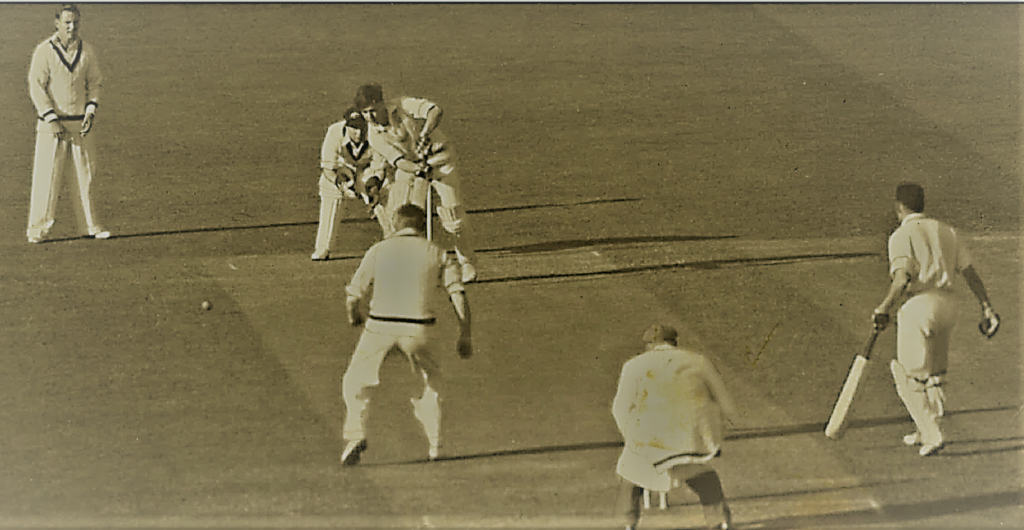
As everyone knows, England won the Ashes in 1953, defying the pessimism of those early weeks. Fingleton’s book was a best-seller and was reprinted thirty years later. Another man might have dined out for life on the praise it contained. For Mike, it was an embarrassment, sabotaging his right to be forgotten and a subject to be avoided by his wiser acquaintances.
In setting aside this wisdom I sense a frown of disapproval from cover point in the Elysian Fields. It might be prudent to move swiftly on.
******
Captaincy of the University was a handful. First, Mike had to select and build a team that would achieve respectable results. Not one of his 1954 eleven would play test cricket, let alone six, as in 1952.
Second, he was expected to sustain the improvement in his own batting, contributing significant scores, in the recent Cambridge tradition.
Then there was the small matter of obtaining a respectable degree. Sheppard wrote of his own experience: “the year’s work had to be done by mid-April if you were going to play cricket for the University….first-class cricket is a tiring game mentally and physically.”
That Bushby succeeded in two of these three goals was an achievement that eluded many of his more famous peers, before and after.
Being Mike, he set himself an additional task. He was perturbed that the traditional rivalry of the Varsity match had got a little out of hand. Some curious passages of play in the 1952 and 1953 encounters had raised eyebrows. This was still a landmark fixture in the Lord’s calendar, for which first day attendance approaching 15,000 might be expected.
Mike had an ally in the cause, in the shape of his opposing captain at Oxford, Colin Cowdrey. It is hard to imagine two men more likely to fret about the spirit of cricket and do something about it. Their advance collaboration inspired a drinks party for the two teams, three sporting declarations, and a bizarre abandonment of the tea interval on the last day. An exciting draw ensued. Bushby and Cowdrey had their reward in The Times headline: “Thrilling day at Lord’s.”
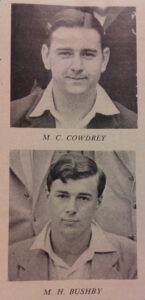
The opposing captains had first met in the 1940s in fixtures beween Tonbridge and Dulwich. They played together for Public Schools at Lord’s in 1949.
Three months after the Varsity match in 1954, Bushby was settling into his new job at Tonbridge School, relieved to have secured employment. Cowdrey was on the boat to Australia.
In the week before Cowdrey’s early death in 2000, Mike took him out for lunch at a pub in Sussex. Memories of the 1950s were on the menu.
Of all the challenges that Mike tackled in that summer, it was his own batting that proved relatively disappointing. His favourite leg-side shots depended on dry pitches and consistent good form, both elusive in 1954. In common with Peter May, he failed to record a large score in his three Varsity match opportunities.
But Mike’s legendary fielding never flagged. From his first match in 1952 to the last, references to Bushby’s fielding in match reports are too numerous to mention. “I never saw him drop a catch,” Dennis Silk told me, adding: “except once off my bowling.” Mike was widely acknowledged to be one of the best fielders in England.
In that final match for Cambridge, everything went wrong on the first day: Bushby lost the toss, Mike “MJK” Smith was dropped in the slips first ball and scored a double century, one of the opening bowlers broke down, and Oxford made over 400 in the day. “When the batsmen were hitting out, Bushby, the captain, fielded magnificently at cover,” wrote CLR James in the Manchester Guardian.
The headline results for the Cambridge season were no worse than for the two previous summers and were better than those of Oxford, despite the class of Smith and Cowdrey. The Cricketer’s review of 1954 reported that “there was a high degree of team spirit and enthusiasm that flourished under the quiet and assured leadership of M.H.Bushby……the fielding was as good as any Cambridge side since the war.”
I was never quite sure how Mike looked back on his cricket at Cambridge. His modesty may have shielded great personal pride, perhaps nagged by visions of what might have been, typical of all reflection on sporting endeavour. He succeeded in his unique version of work-life balance, archiving that intense early period of his life from his contribution to Tonbridge School, whilst sustaining the lifelong friendships it had created.
The start of the 1954 season had been trying for Mike. It rained a lot. Neither he nor Dennis Silk were scoring the runs expected of them. Eventually they had a good partnership against the Pakistan tourists and in the next match against Lancashire at Fenner’s Mike properly found his touch. He reached a fluent century in less than three hours, by then in total command of the bowling with time and wickets in hand. As he was later willing to confess, thoughts entered his mind of a very large score, inspiring confidence in captain and team for the season, perhaps even opening doors for his future.
Fate intervened at this moment of hubris, as recounted in the Liverpool Echo:
O’Brien made a drive towards cover…..and called for a run, changed his mind and sent his captain back. It was too late, for Washbrook hit the stumps with a good throw.
Sixty years on Mike told a different story. “I called the run,” he insisted, “Washbrook was past it by then. I was sent back but was beyond the bowling crease by the time he underarmed a direct hit and half-heartedly appealed.”
Washbrook was indeed in his portly late thirties but nonetheless a legend of post-war English cricket, now captain of Lancashire, a man who could be awkward, not readily crossed by umpires whose livelihood depended on retention on the next year’s first class list. In the heat of the action, Mike had overlooked these pertinent facts and was appalled to see the umpire’s finger raised.
On his way back to the pavilion, in uncharacteristic poor humour, Bushby passed the figure of Winston Place at mid-on. Place was one of the old-time professional cricketers that Mike so much admired, and loved to mimic. He wore his cap at an acute angle; his mouth drooped at the opposite angle, out of the corner of which, sotto voce, he pronounced his verdict:
“Bad luck, sonny.”
******
If you played, watched or talked cricket with Mike Bushby and would like to record here a supplement or correction to this article, or a cricketing reflection about Mike, please use the Comment button below or write to me at bill@treadsoftly.net.
Obituary: Mike Bushby written by David Walsh for the Old Tonbridgian Magazine (page 16)
This article adopts cricketing terminology consistent with its aim of recapturing events of nearly 70 years ago
*******
